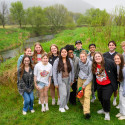Dedication planned for new Wisconsin Veterinary Diagnostic Lab
A dedication event for the new Wisconsin Veterinary Diagnostic Laboratory (WVDL) facility will take place at 3 p.m. on Monday, Oct. 2. The laboratory plays a vital role in Wisconsin agriculture by providing a range of diagnostic tests for animal diseases, as well as related consultation and educational services.
The laboratory is located just south of the University of Wisconsin–Madison School of Veterinary Medicine at 445 Easterday Lane.
With around 78,000 square feet, the new structure has twice the square footage of the laboratory’s previous building on Mineral Point Road. The facility also includes a self-contained Biological Safety Level 3 laboratory that will expand the laboratory’s capability to work with infectious organisms. Construction was completed in September after nearly two years of work.
WVDL is affiliated with the UW System. As specified in state legislation, the WVDL provides testing and diagnostic services for all types of animals in Wisconsin, including production, companion, exotic and wild animals.
In addition to routine diagnostic testing, the WVDL works closely with various state and federal agencies — including the United States Department of Agriculture, the Wisconsin Department of Agriculture, Trade and Consumer Protection, and the Wisconsin Department of Natural Resources — to monitor animal diseases such as chronic wasting disease, mad cow disease and the highly pathogenic avian influenza virus. The laboratory also serves the animal genetics industry by testing the health of bulls and cows before semen and embryos are sold on national and international markets.
According to WVDL interim director Peter Vanderloo, having more space is only one of the benefits of the new building. Because the laboratory also partners with the UW–Madison School of Veterinary Medicine, location is another plus. Says Vanderloo, “We at the WVDL look forward to the opportunity to interact more closely with the faculty, staff and students at the [UW-Madison] veterinary medical school.”




